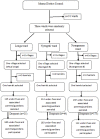Prevalence and risk factors of urogenital schistosomiasis among under-fives in Mtama District in the Lindi region of Tanzania
- PMID: 35442997
- PMCID: PMC9060350
- DOI: 10.1371/journal.pntd.0010381
Prevalence and risk factors of urogenital schistosomiasis among under-fives in Mtama District in the Lindi region of Tanzania
Abstract
Introduction: Despite the ongoing intervention for schistosomiasis control among school-age children in the Lindi region of Tanzania, urogenital schistosomiasis continues to be a public health problem, presumably because other at-risk populations are not covered in praziquantel deworming campaigns. Evidence shows that under-fives become infected in their early life hence the need to understand the disease profile and the risk factors for exposure to infection so as to plan effective control strategies in this group. This study examined the prevalence and risk factors of urogenital schistosomiasis among under-fives in the Mtama district, Lindi region of Tanzania.
Methodology/principal findings: A quantitative community-based cross-sectional study was carried out among 770 participants (385 under-fives and their 385 parents/guardians) in the Mtama district to investigate the burden and the risk factors associated with S. haematobium infection. A single urine specimen was collected from the under-fives and tested for macro and microhaematuria, presence of S. haematobium ova, and intensity of infection. A structured questionnaire gathered on risk factors for S. haematobium exposure in under-fives from their parents/guardians. Data analysis was performed using descriptive statistics, chi-square test, and logistic regression. Prevalence of S. haematobium ova was 16.9%, and that of macro and microhaematuria was 6% and 17.9%, respectively. Of the 65 positive under-fives, 49 (75.4%) 95% CI 65.4-86.3 had a light infection intensity, and 16 (24.6%) 95% CI 13.7-35.5 had a heavy infection intensity. Among the assessed risk factors, the parents/guardians habit of visiting water bodies for domestic routines (AOR: 1.44, 95% CI: 1.13-1.74), especially the river (AOR: 6.00, 95% CI: 1.20-35.12), was found to be a significant risk factor for infection of S. haematobium in under-fives.
Conclusion/significance: A moderate prevalence of S. haematobium was found among the under-fives conceivably with adverse health events. The infected under-fives could be a source of continuity for transmission in the community. An intervention that covers this group is necessary and should be complemented with regular screening, health education campaigns, and an adequate supply of safe water.
Conflict of interest statement
The authors have declared that no competing interests exist.
Figures
Similar articles
-
Persistence of Schistosoma haematobium transmission among school children and its implication for the control of urogenital schistosomiasis in Lindi, Tanzania.PLoS One. 2022 Feb 15;17(2):e0263929. doi: 10.1371/journal.pone.0263929. eCollection 2022. PLoS One. 2022. PMID: 35167622 Free PMC article.
-
Prevalence and factors associated with ongoing transmission of Schistosoma haematobium after 12 rounds of Praziquantel Mass Drug Administration among school age children in Southern Tanzania.Parasite Epidemiol Control. 2023 Sep 1;23:e00323. doi: 10.1016/j.parepi.2023.e00323. eCollection 2023 Nov. Parasite Epidemiol Control. 2023. PMID: 37692460 Free PMC article.
-
Urogenital schistosomiasis among adult male population in an endemic area of southern Tanzania: a descriptive cross-sectional study.BMJ Open. 2024 Jun 17;14(6):e079690. doi: 10.1136/bmjopen-2023-079690. BMJ Open. 2024. PMID: 38889945 Free PMC article.
-
Ultrasound aspects and risk factors associated with urogenital schistosomiasis among primary school children in Mali.Infect Dis Poverty. 2023 Apr 20;12(1):40. doi: 10.1186/s40249-023-01071-6. Infect Dis Poverty. 2023. PMID: 37081494 Free PMC article.
-
Female genital schistosomiasis is a neglected public health problem in Tanzania: Evidence from a scoping review.PLoS Negl Trop Dis. 2024 Mar 11;18(3):e0011954. doi: 10.1371/journal.pntd.0011954. eCollection 2024 Mar. PLoS Negl Trop Dis. 2024. PMID: 38466660 Free PMC article.
Cited by
-
Schistosoma haematobium infection and associated risk factors among pre-school age children in Gambella, Ethiopia.Parasite Epidemiol Control. 2025 Jul 1;30:e00448. doi: 10.1016/j.parepi.2025.e00448. eCollection 2025 Aug. Parasite Epidemiol Control. 2025. PMID: 40687330 Free PMC article.
-
Knowledge, Attitudes, and Practices of Primary caregivers of Preschool children towards Schistosoma mansoni infection in Southern Ethiopia: A community-based cross-sectional study.J Public Health Res. 2025 Jul 30;14(3):22799036251361622. doi: 10.1177/22799036251361622. eCollection 2025 Jul. J Public Health Res. 2025. PMID: 40756694 Free PMC article.
-
Modelling the historical distribution of schistosomiasis-transmitting snails in South Africa using ecological niche models.PLoS One. 2023 Nov 30;18(11):e0295149. doi: 10.1371/journal.pone.0295149. eCollection 2023. PLoS One. 2023. PMID: 38033142 Free PMC article.
-
Review of Recent Prevalence of Urogenital Schistosomiasis in Sub-Saharan Africa and Diagnostic Challenges in the Field Setting.Life (Basel). 2023 Jul 31;13(8):1670. doi: 10.3390/life13081670. Life (Basel). 2023. PMID: 37629527 Free PMC article. Review.
-
Adolescents and young adults excluded from preventive chemotherapy for schistosomiasis control in Northern Tanzania: are they at risk and reservoirs of infection? Prevalence and determinants of transmission in Northern Tanzania.IJID Reg. 2022 Jul 10;4:111-119. doi: 10.1016/j.ijregi.2022.07.008. eCollection 2022 Sep. IJID Reg. 2022. PMID: 35898620 Free PMC article.
References
-
- World Health Organization. Schistosomiasis 2019. https://www.who.int/news-room/fact-sheets/detail/schistosomiasis (Accessed September 23, 2021).
-
- Mutsaka-Makuvaza M.J, Matsena-Zingoni Z, Katsidzira A, Tshuma C, Chin’ombe N, Zhou XN, et al. Urogenital schistosomiasis and risk factors of infection in mothers and preschool children in an endemic district in Zimbabwe. Parasites Vectors. 2019; 12:427. doi: 10.1186/s13071-019-3667-5 - DOI - PMC - PubMed
Publication types
MeSH terms
Substances
LinkOut - more resources
Full Text Sources




